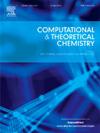In-Silico scrutinization of (Al, Ga, B, Si, Ge, and P)-doped C60 in sensing EGCG: An application based DFT study
IF 3
3区 化学
Q3 CHEMISTRY, PHYSICAL
引用次数: 0
Abstract
Since the invention of the biological sensor, many proposals and techniques have been developed to improve biosensor functionality. Because of its unique physicochemical properties, the recently developed carbon material “fullerene” improves the possibilities for developing highly sensitive biosensors. This study aims to conduct a computational investigations on utilization of fullerene (C60) and the addition of elements as impurities into the same (doped-C60) as sensors for EGCG. The introduction of impurities into nanomaterial structures increases intermolecular interaction. The fullerene structure, doped with Al, Ga, B, Si, Ge, and P, has been studied as an adsorbent. Density Functional Theory (DFT) based methods are used to investigate the interaction between fullerene or doped fullerene and EGCG. The interaction between the optimized doped structures and the optimized EGCG structure was investigated using the hybrid functional B3LYP, and 6-31G(d) basis set. To the best of our knowledge, this is the first such observation related to the intermolecular interaction between EGCG and doped-C60 and its sensitivity. The sensitivity of the doped-C60 towards EGCG were evaluated by the HOMO–LUMO energy gap and Conceptual Density Functional Theory (CDFT). The results depict Al-doped fullerene shows higher interaction/adsorption potential and sensitivity towards EGCG, as compared to the other studied C60 materials. To acquire knowledge about the nature of intermolecular interactions during the adsorption phenomena, we have computed the Quantum Descriptors, Density of States(DOS) plots, Quantum Theory of Atoms in Molecules (QTAIM), and Non-Covalent Interaction (NCI) analysis. By creating high-sensitivity sensors for bioactive molecules like polyphenolic compounds (EGCG) in exploration of variety of dopants can be used in drug delivery, public health, and environmental monitoring. So, this study aims to improve biosensor technology and lays the foundations for future modular and accurate molecular sensor designs.
求助全文
约1分钟内获得全文
求助全文
来源期刊

Computational and Theoretical Chemistry
CHEMISTRY, PHYSICAL-
CiteScore
4.20
自引率
10.70%
发文量
331
审稿时长
31 days
期刊介绍:
Computational and Theoretical Chemistry publishes high quality, original reports of significance in computational and theoretical chemistry including those that deal with problems of structure, properties, energetics, weak interactions, reaction mechanisms, catalysis, and reaction rates involving atoms, molecules, clusters, surfaces, and bulk matter.
 求助内容:
求助内容: 应助结果提醒方式:
应助结果提醒方式:


